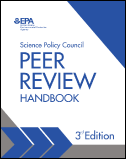Peer Review Program
Science & Technology Policy Council
Science & Technology Policy Council
- Science & Technology Policy Council Home
- About the STPC
- Policies, Guidance & Initiatives
- Science Inventory Peer Review Agenda
Quality environmental information is integral to EPA's mission to protect human health and the environment. Peer Review, the evaluation of a product by experts in that field who were not involved in that product's development, is a critical tool used by EPA to ensure that only high-quality, sound science is released and/or used by the Agency. High quality information enables scientists and stakeholders alike to effectively participate in assessing and managing human health and environmental risks.
The Peer Review Handbook is a how-to manual that is used by staff across EPA and is often referred to by external stakeholders as a model of good peer review practices.
The Peer Review Policy (and memo signed by the Administrator on January 31, 2006) (PDF) (4 pp, 261K) and 3rd Edition of the Handbook (PDF) (190 pp, 1.8MB) benefits from insights gained from implementing the program over the last decade, strengthens the explanation of ethical standards, and incorporates the provisions of the Office of Management and Budget (OMB) Final Information Quality Bulletin for Peer Review (PRB). The OMB PRB (PDF) (41 pp, 239K) contains provisions for the conduct of peer review at all federal agencies in order to enhance transparency and accountability and applies to “influential scientific information” (ISA) and “highly influential scientific assessments” (HISA). Please note that in June 2012, Figures 1 and 3 of the Handbook were modified to clarify requirements for ISIs and HISAs.

Peer Review Handbook, 3rd Edition (PDF) (190 pp, 1.8MB)
- Modified Figures 1 and 3 (PDF) (2 pp, 451KB)
Addendum to the Peer Review Handbook, 3rd Edition: Appearance of a Lack of Impartiality in External Peer Reviews
This addendum provides:
- a definition of an appearance of a lack of impartiality for individuals who serve on peer review panels either as Government employees or as experts hired under a contract mechanism,
- the criteria for applying the definition of an appearance of a lack of impartiality, and
- illustrative examples.
View this Addendum to the Peer Review Handbook (PDF) (7 pp, 77KB)
Background
Peer Review has a long and exemplary history at the EPA
- In response to the 1993 report Safeguarding the Future: Credible Science, Credible Decisions, EPA issued an Agency-wide policy for peer review.
- In 1994 EPA reaffirmed the central role of peer review and instituted an Agency-wide implementation program .
- In 1998, a Peer Review Handbook was created as a single, centralized form of implementation guidance for Agency staff and managers.
- in December 2000, the Peer Review Handbook was revised and reissued.
- In 2006 Peer Review Policy and Handbook are again updated. View the 2006 Policy (PDF) ( 2 pp, 116KB). View the 2006 Handbook (PDF) (190 pp, 1.8MB).
Clarification
The first example provided in Appendix D (Examples of Peer Review Charges) should be considered as an example of a peer consultation charge rather than for peer review. The charge, US EPA Science Advisory Board Consultation on Suspended and Bedded Sediments, may be used as an example only when seeking peer input in the development of an Agency work product. Peer consultation (aka peer input) may be sought from a variety of external experts who may be considered stakeholders, whereas the goal of formal peer review is to obtain an independent, third-party review of a product from experts who have not contributed to its development. As noted in section 1.2.5 of the Handbook, peer input is not a substitute for peer review.
To order a hard copy of the Peer Review Handbook - 3rd Edition, EPA document number EPA/100/B-06/002, call National Service Center for Environmental Publications at 1-800-490-9198 or through the Internet on the World Wide Web at: http://www.epa.gov/ncepihom/ordering.htm
- 2006 Peer Review Policy Memo (PDF) (2 pp, 29KB)
- 2006 Peer Review Policy (PDF) (3 pp, 23KB)
- 3rd Edition Peer Review Handbook (PDF) (190 pp, 1.8MB)
The following links are for archival reference purposes only.
- 2nd Edition Peer Review Handbook - Cover Memo (PDF) (2 pp, 26KB)
- 2nd Edition Peer Review Handbook (PDF) (185 pp, 3.6MB)
You will need Adobe Reader to view some of the files on this page. See EPA's PDF page to learn more.
![[logo] US EPA](https://cybercemetery.unt.edu/archive/oilspill/20120921192951im_/http://www.epa.gov/epafiles/images/logo_epaseal.gif)